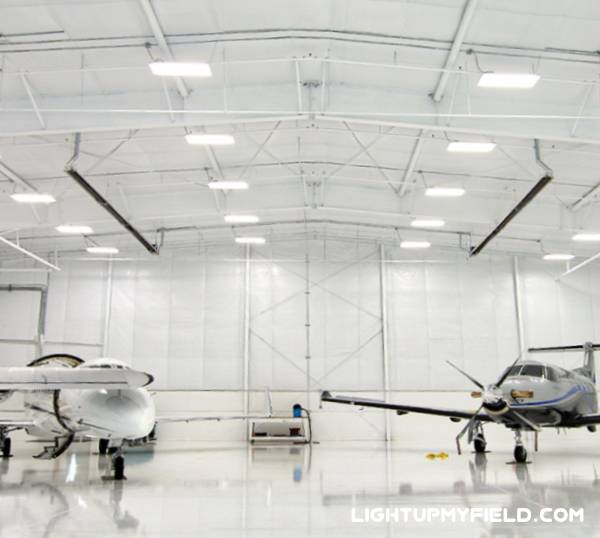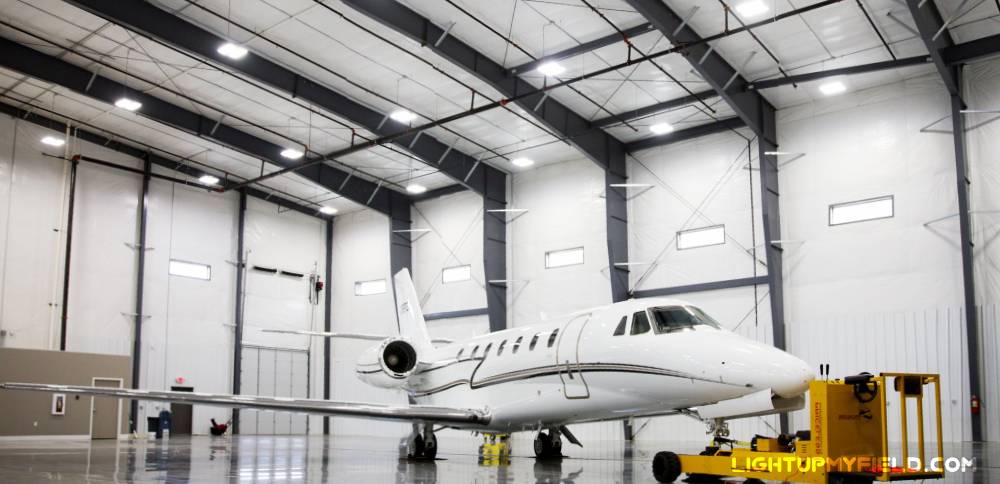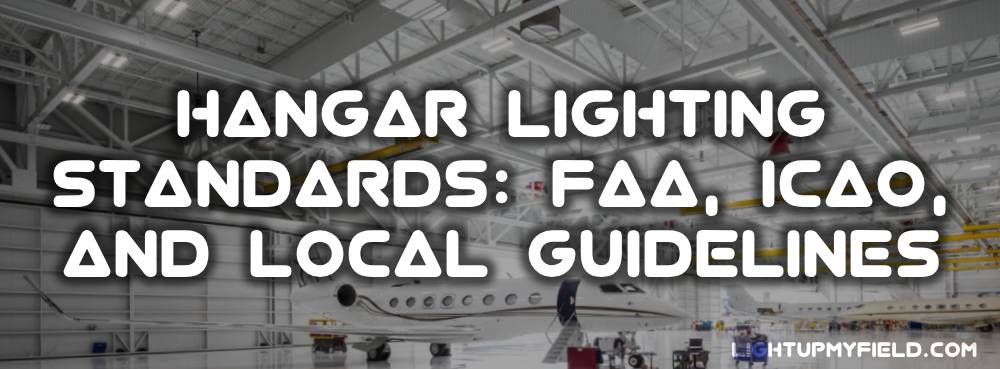Lighting in aircraft hangars might seem like just another part of the design process, but it plays a huge role in how well everything works inside. From maintenance inspections to cleaning and painting, every detail needs to be visible—clearly and consistently. That’s where lighting standards come in. Different organizations like the FAA (Federal Aviation Administration) and ICAO (International Civil Aviation Organization) have their own rules about how hangars should be lit. On top of that, there are also local codes and best practices that engineers and designers need to keep in mind.
So how bright does a hangar actually need to be? What kind of color temperature is considered ideal? And how do we make sure we’re ticking all the boxes—not just on paper, but in actual day-to-day use? Let’s break it down and go over what the FAA, ICAO, and common local guidelines say when it comes to proper hangar lighting.
Table of Contents
ToggleFAA and ICAO Lighting Standards for Aircraft Hangars
What Are the FAA’s Lighting Requirements?
 When it comes to lighting inside aircraft hangars, the FAA doesn’t leave much room for guesswork. Their standards are all about making sure maintenance crews have the right visibility for every task, from quick checks to deep repairs.
When it comes to lighting inside aircraft hangars, the FAA doesn’t leave much room for guesswork. Their standards are all about making sure maintenance crews have the right visibility for every task, from quick checks to deep repairs.
According to FAA Engineering Brief No. 83 and related documents, maintenance zones should reach about 500 lux, which translates to roughly 46 foot-candles (fc). To put that into perspective, 500 lux is about five times brighter than what you’d find in a typical office space, which usually sits around 300 lux. Why so bright? Because in a hangar, you’re dealing with tiny rivets, complex wiring, and critical surfaces where even a small crack matters. Lower lighting can easily hide defects that should never go unnoticed.
For less demanding areas—think storage rooms or general movement zones—the FAA suggests 200 to 300 lux, or about 18 to 28 fc. It’s still brighter than your living room, but not as intense as what’s needed over an aircraft wing or engine compartment.
What About Color Temperature?
The FAA also points out that color temperature makes a huge difference in how clearly technicians see details. They recommend a range between 4000K and 5000K, which falls in that sweet spot of bright, neutral white light. Why does this matter? At around 4000K, you get enough warmth to keep things comfortable, while 5000K brings a crisp daylight-like quality. That means corrosion, oil leaks, and paint variations stand out instead of blending in. Try doing the same work under a warm 2700K light—it’ll feel like working in a dimly lit restaurant, not ideal for spotting hairline cracks in metal.
How About Uniformity?
Now let’s talk about lighting uniformity, which is another big deal in the FAA’s playbook. They expect a uniformity ratio of 3:1 or better. In plain English, that means the brightest spot in your hangar should be no more than three times brighter than the darkest spot. Sounds simple, but it makes a world of difference. Poor uniformity forces the human eye to constantly adjust when moving between bright and dim areas, which leads to eye strain and slows down the work pace. And in a 200-foot-wide hangar, these variations can be very noticeable if the layout isn’t carefully designed.
To put it in numbers, if your brightest spot is hitting 600 lux, the darkest part of the working plane shouldn’t fall below 200 lux. Anything worse than that starts creating uncomfortable shadows—definitely not what you want when performing detailed inspections on multi-million-dollar aircraft.
What Does the ICAO Recommend?
Now, let’s switch over to ICAO, the global authority setting aviation guidelines for international airports and hangars. While the FAA is very specific for U.S. operations, ICAO aims for flexibility since its standards apply worldwide.
According to ICAO Annex 14 and the Airport Services Manual, the target lighting levels for detailed maintenance areas also land around 500 lux, which matches FAA’s recommendation. For non-technical zones, ICAO accepts a lower range—often between 200 and 300 lux—similar to FAA.
So, where does ICAO differ? Two main points: glare control and color rendering.
Why Is Glare Control Such a Big Deal?
ICAO really stresses minimizing glare because harsh reflections can reduce visibility and even cause discomfort over long shifts. Imagine working on a shiny aircraft fuselage under bright lights that bounce straight into your eyes—after a few hours, that’s a recipe for fatigue and mistakes. That’s why ICAO suggests fixtures with diffusers, proper mounting angles, and careful beam control.
How About Color Rendering?
ICAO also places special attention on CRI (Color Rendering Index). They recommend a CRI of at least 80, which means the light source renders colors almost as accurately as natural sunlight. Why does that matter? When you’re checking wiring harnesses with multiple colored cables or inspecting painted surfaces for inconsistencies, color accuracy is everything. A lower CRI might make a blue wire look grayish or dull, which isn’t something you want to risk during maintenance.
Shared Goals Between FAA and ICAO
Both organizations—despite the slight differences—agree on one big point: lighting should make aircraft servicing safe, accurate, and efficient. That means easy access for fixture maintenance, minimal shadowing across working surfaces, and ideally, adjustable controls so technicians can dim or brighten zones as needed.
If you think about it, these aren’t just theoretical numbers on a spec sheet. They affect how smoothly hangar operations run every single day. A well-lit hangar speeds up work, cuts down errors, and keeps the crew more comfortable during those long shifts. Poor lighting? That’s when mistakes happen, inspections get delayed, and costs start adding up.
FAA vs. ICAO Hangar Lighting Standards at a Glance
| Parameter | FAA Requirements | ICAO Recommendations |
|---|---|---|
| Lighting Level – Maintenance Areas | 500 lux (~46 foot-candles) | ~500 lux (similar to FAA) |
| Lighting Level – Non-Technical / Storage | 200–300 lux (18–28 foot-candles) | 200–300 lux |
| Color Temperature | 4000K–5000K (neutral white light) | Not specified, but generally similar range |
| Uniformity Ratio | 3:1 or better (brightest to darkest) | Similar expectation, no strict ratio stated |
| Color Rendering Index (CRI) | Not explicitly stated | ≥80 CRI (for accurate color recognition) |
| Glare Control | Mentioned but less emphasized | Strong emphasis on reducing glare |

A Look at Local Guidelines and Design Preferences
What Do Local Building Codes Usually Require?
While the FAA and ICAO lay down the big-picture rules, local authorities often bring in their own set of codes and regulations. These local requirements typically focus on energy efficiency, safety, and sustainability, which means designers can’t just stop at meeting the global standards—they’ve got to check off local boxes too.
Take the United States as an example. Many states and cities follow IES (Illuminating Engineering Society) guidelines for recommended lighting levels, but they also expect compliance with energy regulations like California Title 24 or ASHRAE 90.1. These standards don’t just talk about brightness—they set limits on energy consumption, control systems, and even fixture performance.
One common requirement you’ll see is the integration of automatic daylight sensors and motion controls. The logic is simple: why waste energy lighting an empty hangar when no one’s there? These sensors can cut energy use by up to 30–40%, which is a big deal when you consider the sheer size of most hangars.
Another key metric is luminaire efficacy. In some areas, you’re expected to install fixtures that hit at least 120 lumens per watt. Compare that to older metal halide fixtures, which often delivered only 70–90 lumens per watt, and you’ll see why LEDs have basically taken over the hangar lighting world.
Internal Standards from Airports and Airlines
It’s not just local governments calling the shots. Airports and major airlines often have their own internal lighting standards, built from years of operational experience. These internal guidelines sometimes go beyond FAA or ICAO recommendations because they’ve seen what works—and what doesn’t—on the ground.
For example, a large maintenance hub might require higher illumination levels in engine service areas, or extra glare control in zones where reflective surfaces are common. They may even mandate backup power systems for the lighting grid so technicians aren’t left in the dark during outages.
What Do Designers Typically Aim For in Practice?
In real-world projects, lighting designers don’t usually stop at 500 lux. Many modern hangars are designed for 700 to 800 lux in maintenance zones. Why? Because brighter, well-distributed lighting helps crews spot defects faster and work more comfortably, especially during extended shifts.
Designers also tend to choose high bay LED fixtures because they deliver better light uniformity and require way less maintenance than older options like fluorescent or metal halide. LEDs can last 50,000 to 100,000 hours, meaning fewer disruptions and lower long-term costs.
Beam angles matter too. Most hangars opt for fixtures with a 60° to 90° beam spread, which provides focused coverage without creating harsh hot spots or wasting light. And when glare becomes an issue—especially on polished aircraft surfaces—diffusers or baffles are added to soften the output. This isn’t just about comfort; reducing glare means fewer mistakes and less fatigue.
A Touch of Flexibility with Tunable LEDs
Here’s a trend that’s been gaining traction: tunable white LED systems. These allow you to shift the color temperature from around 3500K up to 6000K. Why bother? Because different tasks (and times of day) benefit from different lighting tones. A cooler 5000–6000K light mimics daylight and keeps workers alert during precision tasks, while a slightly warmer tone can make night shifts less harsh on the eyes. It’s not required by any code, but it’s a game-changer for worker comfort and performance.
Why It Matters to Get the Lighting Right
Does It Really Make That Big of a Difference?
Absolutely. Lighting in a hangar isn’t just about seeing where you’re going—it’s about how well technicians can perform precision work on multi-million-dollar aircraft. When you’re dealing with complex systems, thousands of wires, and components the size of a coin, visibility can make or break the outcome.
Poor lighting doesn’t just slow down work; it increases the chances of mistakes. Imagine trying to spot a hairline crack in a turbine blade under dim lighting. It’s easy to miss, and that can have a ripple effect on safety and maintenance schedules. In fact, studies show that in environments operating at 200 lux instead of 500 lux, error rates can jump by 20–30%, especially during visual inspection tasks. That’s not just a small inconvenience—it’s a serious operational risk.
Lighting also impacts worker fatigue. Under-lit areas force the eyes to work harder, leading to strain and slower reaction times. Over a 10-hour maintenance shift, that can mean reduced accuracy and slower turnaround. On the flip side, a well-designed hangar lighting system makes tasks quicker, safer, and more comfortable, which directly translates into better productivity and fewer delays.
Safety Isn’t Just About the Aircraft
Lighting isn’t only about maintaining the plane—it’s about keeping people safe too. A well-lit hangar helps spot oil spills or hydraulic leaks before someone slips. It makes emergency exits visible during power outages. And when something goes wrong, good lighting can shave seconds off an emergency response—seconds that matter.
Think of the scale: a typical wide-body aircraft hangar can cover 100,000 square feet or more, often with multiple teams working at different heights. Shadows, glare, or dark corners aren’t just annoying—they can create real hazards, like tripping over hoses or missing safety signage.
What About Compliance and Inspections?
Here’s where things get real for operators: if your hangar lighting doesn’t meet FAA, ICAO, or local standards, you could run into serious compliance issues. During FAA Part 139 inspections or even routine audits by insurers, lighting is one of those items that shows up on the checklist. Fail to meet the required lux levels or uniformity ratios, and you might face penalties, operational delays, or expensive retrofits.
There’s also a financial angle. Many grants and certifications—such as LEED, WELL, or energy efficiency programs—require proof that your lighting system meets both performance and energy codes. Skipping these standards can cost you in the long run, either through lost incentives or higher energy bills from outdated systems.
Getting it right from the start means avoiding rework, downtime, and failed inspections. It also positions your facility as compliant, efficient, and ready for future audits.
Conclusion
Lighting in aircraft hangars isn’t just about flipping a switch and calling it a day. It’s about meeting the needs of technicians, complying with safety regulations, and designing a system that holds up over time. The FAA and ICAO have laid out clear expectations—500 lux, 4000K–5000K color temperature, good uniformity—and local guidelines only add more layers to the mix.
A good lighting setup might not be the flashiest part of a hangar, but it’s one of the things that makes everything else work better. Whether you’re retrofitting an older space or building from scratch, keeping those standards in mind means fewer problems later and a better environment for everyone using the space. So when planning your next hangar project, it’s worth giving lighting the attention it deserves.

